Disclaimer & Copyright Notices; Optimized for the MS Internet Explorer
Treatment of stormwater runoff
Soil & Water Conservation Society of Metro Halifax (SWCSMH)
Updated: August 14,
2015

Contents:
Introduction and a note of caution on treatment methodologies
"Laser particle sizing has also indicated
that a considerable proportion of the particulates in road runoff are
less than 10 Ám. This size fraction is difficult to capture in current
stormwater pollution control devices and has been shown to contain
significant quantities of heavy metals, which are of concern in aquatic
ecosystems." (Drapper et al)
A note of caution: There have been conflicting results in the long term removal of typical stressors in storm drainage using constructed (or engineered) wetlands. Hence care has to be taken to size them adequately.
In the extreme case, treatment of urban and suburban stormwater by traditional wastewater treatment plants (WWTP)
based on the tertiary removal process may be required. This may imply
considerable capital costs and operation & maintenance.
Rate of settling in pure, still water
Rate of settling in pure, still water (temp=10oC, sp. gravity of particles=2.65, shape of particles=spherical) (Welch, 1935)
| Material | Diameter (mm) | Hydraulic subsiding value (mm/sec) | Time required to settle 1 ft.
|
|---|
| Gravel | 10.0 | 1000.0 | 0.3 sec
|
| Coarse sand | 1.0 | 100.0 | 3.0 sec
|
| Fine sand | 0.1 | 8.0 | 38.0 sec
|
| Silt | 0.01 | 0.154 | 33.0 min
|
| Bacteria | 0.001 | 0.00154 | 55.0 hr
|
| Clay | 0.0001 | 0.0000154 | 230.0 days
|
| colloidal particles | 0.00001 | 0.000000154 | 63 years
|
Constructed Wetlands
Enter ![[Img: animated doors]](../VIEW/ICON/AN/doorin2.gif) for a bibliography on wetlands
for a bibliography on wetlands
Introduction
(cf. Strecker et al., 1992)
Wetlands are receiving attention as attractive systems for removing
pollutants from stormwater surface runoff before the runoff enters
downstream lakes, streams, and other open water bodies. Wetlands have long
been employed for the treatment of wastewaters from municipal, industrial
(particularly acid mine drainage), and agricultural sources. The U.S.
Environmental Protection Agency (EPA) encourages the use of constructed
wetlands for water pollution control.
"The term `wetlands' means those areas that are inundated or
saturated by surface or ground water at a frequency and duration
sufficient to support, and that under normal circumstances do support, a
prevalence of vegetation typically adapted for life in saturated soil
conditions. Wetlands generally include swamps, marshes, bogs, and similar
areas".
A significant issue is whether natural wetland systems should be used
as stormwater control measures. In general, natural wetlands have been
found to be somewhat less predictable than constructed wetlands in terms
of pollutant removal efficiency. This difference may be due to the fact
that constructed wetlands have generally been engineered to provide
favorable flow capacity and routing patterns.
People often question whether it is appropriate to use a natural,
healthy wetland for such purposes. The concern is whether the modified
flow regime and the accumulation of pollutants will result in undesirable
environmental effects. A general consensus from the literature is that the
use of a healthy natural wetland for stormwater pollution control should
be discouraged.
One pre-treatment technique would be to use pond areas to provide an
opportunity for suspended materials to settle out before the flows enter
the wetland. Other possible options include routing inflows to the
wetlands through upstream grass swales, oil/water separators, heavily
vegetated areas (e.g. thick, shallow cattail area), and overland flow
areas.
"....... several trends were noted. First, constructed systems were
generally found to have a higher average removal performance than natural
systems, with less variability; and second, larger wetlands as compared to
watershed size also showed the same trend, a higher average removal
performance, with less variability".
Adequate sizing is imperative:
Following is a listing of the wetlands that
were researched for their ability to treat stormwater runoff as well as
a map of the USA showing their location. Some of the constructed
wetlands are located in regions with harsher climate and/or more
intensive snow cover than in Nova Scotia (cf. Strecker et al., 1992).
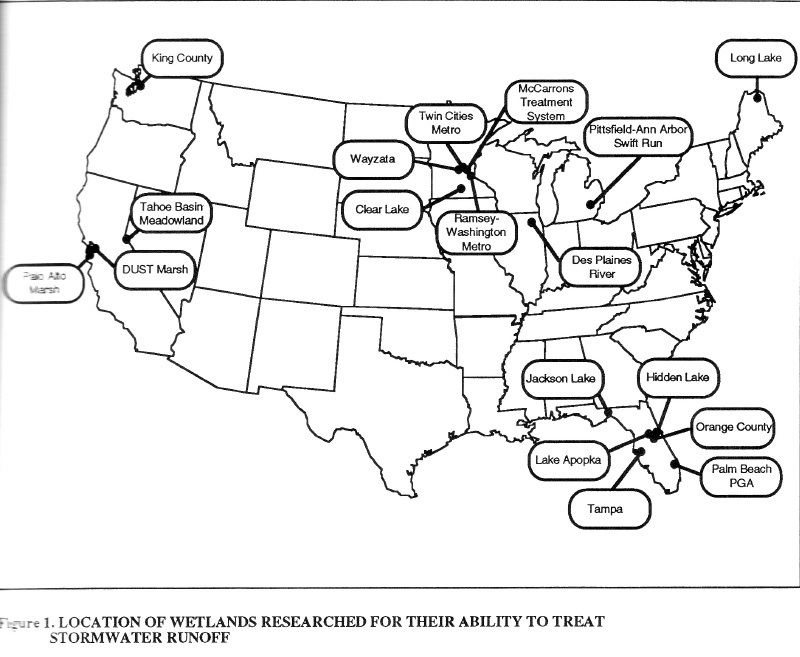
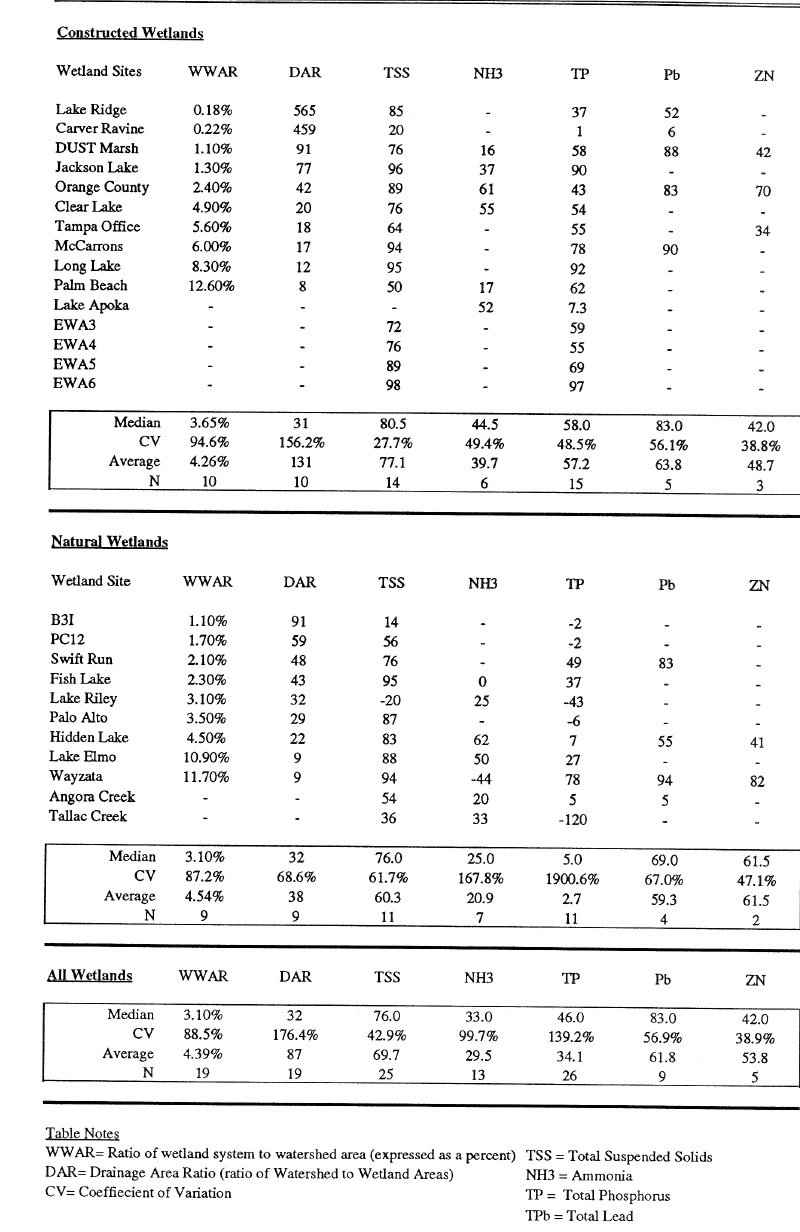
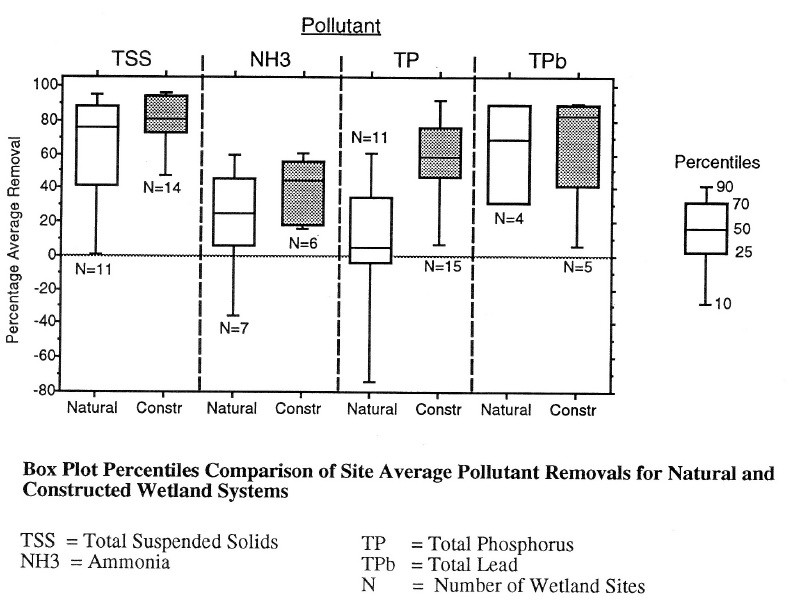
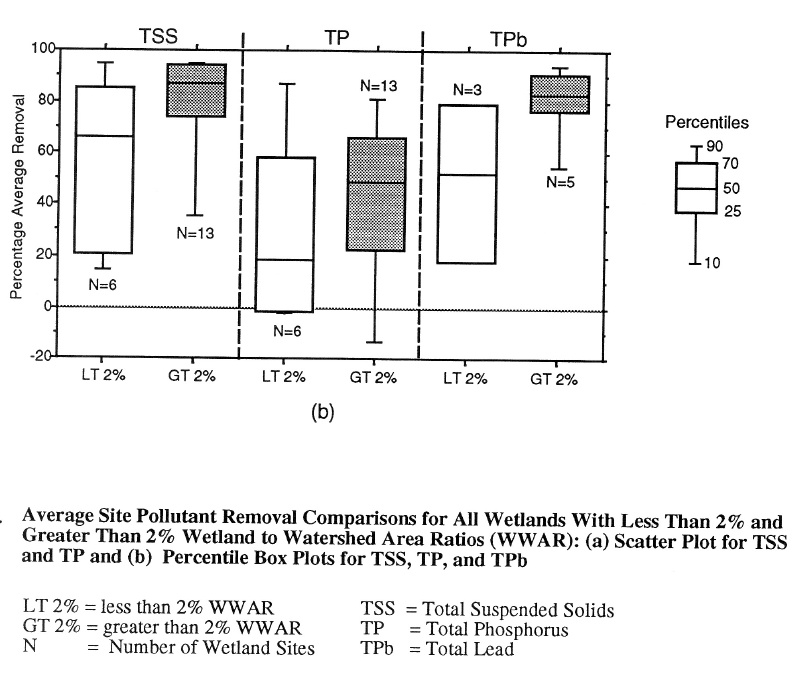
Design Features of Constructed Wetlands for Nonpoint Source (NPS) Treatment
(cf. Jones, W.W. 1996)
Constructed wetlands are employed
to treat nonpoint sources such as excess runoff, eroded soil and
nutrients. Natural wetlands should not be used to treat NPS pollution
without first conducting a thorough environmental assessment to insure
that the wetland can support the necessary treatment without becoming
degraded. Likewise, using wetlands for treating toxic wastes is not
recommended without extensive evaluation.
How do constructed wetlands work to reduce NPS pollution?
Constructed wetlands provide storage capacity
for runoff water within their basins. In addition, organic soils found
in mature wetland systems act like a sponge to retain water and allow
infiltration of surface water into the groundwater. This decreases not
only runoff volume, but also peak discharges which may otherwise cause
flooding or erosion downstream. As channelized flow enters a wetland,
the velocity is reduced as the water spreads out over the wetland.
Velocity is further reduced by the frictional resistance of aquatic
vegetation. It is this reduction in velocity which is most responsible
for sediment and nutrient retention in constructed wetlands. As the
velocity of flowing water slows, it loses the energy needed to keep
particles in suspension, and these particles and associated nutrients
then settle out.
Nutrients such as phosphorus and
nitrogen are trapped and retained in constructed wetlands by several
mechanisms: burial in sediments, chemical breakdown (e.g.,
denitrification and ammonia volatilization), and through assimilation
by aquatic plants and bacteria. The primary mechanism for phosphorus
removal is adsorption to wetland soils and precipitation reactions with
calcium, aluminum and iron. In most cases,
phosphorus retention by vegetation is only seasonal, as it is taken up
by growing plants and released with vegetation dieback in the Fall.
How can you enhance the functioning of constructed wetlands?
- Loading rate:
- Ideally, for optimal performance, the size of the constructed
wetland should be from 1 to 5 % of the size of its drainage area.
Designing hydraulic loading by analyzing existing channel discharge or
watershed runoff coefficients is more precise than the 1 to 5 % rule
above and this more intensive hydraulic loading determination is
recommended.
- Phosphorus removal efficiency declines with increasing
phosphorus loading. With high loading rates, adsorption sites become
saturated and there is insufficient capacity for biotic assimilation.
There are cases where overloaded wetlands have become phosphorus
sources to downstream lakes.
- Hydraulic retention time:
- The longer water remains in the wetland the greater chance of
sedimentation, adsorption, biotic processing and retention of
nutrients. Proper sizing of the wetland is important, but restricting
the size of the wetland outlet is also effective. For wetlands with
channel flow, the outlet cross sectional area should be less than 1/3
that of the inlet.
- Water velocity:
- Peak water velocities through the wetland should not exceed 1.5
fps. High velocities can wash out rooted vegetation and scour deposited
sediments. Ideally, flow velocities should be less than 0.6 fps.
- Soils:
- fine-textured clay soils and soils with high organic matter content
have more adsorption sites for retaining nutrients. Available calcium,
aluminum and iron in the soil enhance precipitation reactions with
phosphorus.
- Water depth:
- Water depths less than 40 inches result in greater resistance to flow and favour aquatic vegetation.
- The preferred depth ranges are for,
- emergent plants= 0-1 ft of water
- rooted surface plants= 1-2 ft of water
- rooted submersed plants= 1.5-6.5 ft of water
- Pools deeper than 40 inches should be included in the wetland
design to maximize sediment deposition and provide winter fish habitat.
- Maximize edge:
- Sinuous edges between the terrestrial and aquatic zones provide
more resistance to flow and more edge habitat for plants and animals.
Islands create additional edge, plus they provide refuge from predation
for nesting birds.
- Minimize edge slope:
- The terrestrial-aquatic boundary should have a very gradual slope.
This allows for the establishment of a continuum of emergent species
and reduces the erosive effects of waves hitting a sharp shoreline
boundary.
- Persistent emergent vegetation:
- Persistent emergent vegetation has stems which persist even after
the growing season. This provides year-round resistance to water flow.
- These plants include: cattail (Typha sp.), iris (Iris pseudacorus or I. Versicolor), rush (Juncus sp.), cordgrass (Spartina sp.), reedgrass (Calamagrostis sp.), sawgrass (cladium jamaicense) and switchgrass (Panicum virgatum).
- Woody plants, such as alder (Alnus sp.), buttonbush (Cephalanthus occidentalis), black willow (Salix nigra) and others are useful edge species with persistent stems.
- Aquatic bed or submergent vegetation removes nutrients
seasonally, but does not offer significant frictional resistance to
suspended sediments.
Maintenance:
Constructed wetland planning should not
overlook the need for long-term maintenance. Additional vegetation
planting may be required to speed plant coverage, replace damaged
plants or to try more suitable varieties. Perimeter fencing may be
required. Maintenance may be needed to control the spread of undesired
plant species such as purple loosestrife. Inlets and outlets can become
blocked with debris which will require periodic removal. Inlet and
outlet structures should be inspected weekly and especially following
big storm events. Most importantly, if the wetland functions well as a
sediment and nutrient trap, it may eventually require dredging to
remove accumulated materials. Thus, vehicular access to the site must
be provided for maintenance vehicles and possibly dredging equipment.
Case histories of constructed wetlands and ponds:
- In contrast to the treatment of
municipal or mining waste water, whose flow rates and compositions tend
to be predictable and relatively constant, storm-water flows and
compositions vary considerably, depending on the land uses in the
catchment basin and the frequency and intensity of rain/snow events. In
addition, constructed wetlands may not be effective in treating certain
storm-water contaminants, such as road salt and some organic compounds.
- Pretreatment of sediment using sedimentation/siltation ponds
may be necessary to prevent the sediment from choking the wetland soils
and rendering them ineffective.
- Several trends were noted. First, constructed systems were
generally found to have a higher average removal performance than
natural systems, with less variability; and second, larger wetlands as
compared to watershed size also showed the same trend, a higher average
performance, with less variability. Assessment was made based on <2%
and >2% size wetlands in relationship to the catchment areas, and 2%
seems to be sufficient, although note the following quote, "...........
at this time we are not suggesting that minimum of a 2 per cent DAR is
the proper design criteria for constructed wetlands." (Strecker et al. 1992).
- "People often question whether it is appropriate to use a
natural, healthy wetland for such purposes. The concern is whether the
modified flow regime and the accumulation of pollutants will result in
undesirable environmental effects.
.......................................... A general consensus from the
literature is that the use of a healthy natural wetland for stormwater
pollution control should be discouraged."
McCarrons Treatment Facility System:
(cf. Strecker et al. 1992)
This facility consisted of a
30-acre detention basin with an average
depth of 1.2 feet and a 6.2-acre constructed wetland with an average
depth
of 2.5 feet. The detention basin received stormwater and then
discharged to the wetland. The contributing watershed consists of 600
acres of primarily
urban land use. The predominant vegetation in the wetland consists of
cattails with other emergent plant species.
Overall, they found very good results for the system. The following removal efficiencies were given:---
- % removal for Detention basin:
- TSS-91%
- TP-78%
- TN-85%
- TPb-85%
- % removal for Wetland:
- TSS-87%
- TP-36%
- TN-24%
- TPb-68%
The detention basin removed the fraction
of pollutants that are more readily settled and treated, leaving the
wetland with the finer, more difficult to treat pollutants.
Recommendations of Berezowsky, Boojum Technologies Ltd., Toronto:
(cf. Berezowsky. 1997)
Considering the diverse nature of
the contaminants found in urban stormwater, the most effective solution
appears to be a multi-stage system, such as the "marsh-pond-meadow" or
the "Max-Planck-Institute" process.
- The
marsh-pond-meadow system: This consists of (1) a bar screen and
aeration cell using a floating surface aeratior, (2) a lateral-flow
marsh planted with cattails in a sand medium, (3) a pond with aquatic
macrophytes and herbivorous fish, (4) a meadow planted with red canary
grass, and (5) a chlorination chamber. The removal efficiency is
reported to be 77% for ammonia nitrogen and 82% for total phosphorus.
- The
Max-Planck-Institute Process: This design is used in France and was a
model for a system implemented in Oaklands Park, United Kingdom. The
system consists of four or five stages in cascade, each with several
basins laid out in parallel and planted with emergent macrophytes in
gravel. The flow pattern in the first two stages is vertical, while the
final ones have horizontal flow. In the French system, removal of
suspended solids and BOD is good, but with poor results for nitrogen
and phosphorus, perhaps because of high loading rates.
Lake Tahoe:
(Reuter et al 1992)
Wetlands treatment of stormwater has been reported (Reuter et al 1992,
Verry et al 1982, Brown 1985). Results from a newly constructed wetland
to treat stormwater in a cold climate region of California at Lake Tahoe
were encouraging. Gravel-filled constructed wetlands (Lake Tahoe) provide
a much greater surface area for bacterial attachment than is possible in
natural wetlands, thereby enhancing the substratum to water volume contact
ratio, and hence need less land area than natural wetlands. Constructed
Wetlands are most suitable as mitigation for small development projects
where land is limited. These projects include golf courses that receive
fertilizers, small commercial facilities, small housing developments, etc.
They are generally limited in efficiency by the volume of water they
can retain (4-8 day retention). It may be unrealistic to rely on small
constructed wetlands to treat large urban areas. Other solutions like
partial diversion, a combination of treatment systems, etc will have to be
found. The age-old excuse of questioning the utility of constructed
wetlands in cold climate regions was irrefutably proven to be false in not
only the Lake Tahoe case but also in other cases elsewhere.
Lake Sammamish Basin, Washington:
(Lake Sammamish Initiative)
State-of-the-art stormwater treatment system for removing phosphorous
in runoff from a 460-acre residential development incorporates a dry pond
for detention and a wet vault for pretreatment, followed by a filter with
underdrains.
Shop Creek Project, Colorado:
(Urbonas and Ruzzo 1985)
Based on peer reviewed literature,
a concept was developed in the State of Colorado, where experts advised
mandatory removal of 50% of the expected post-development export of
total phosphorus in urban stormwater before approving new subdivisions
. They felt anything above 50% would be unduly costly. For that, their
consultants recommended utilizing wet detention ponds (not dry ponds)
to intercept the first half-inch of runoff (the first flush carries
most of the urban pollutants, not just TP), a certain detention time
(based on chemistry, etc.) followed by sand filtration prior to
discharge into natural watercourses, directly or indirectly. It
appears, there was a successful demonstration project, the Shop Creek
Project which implemented sound engineering methodology of reducing the
TP load in the storm water in a new subdivision prior to discharge into
the Cherry Creek Reservoir (consult the Cherry Creek Basin Water
Quality Authority, Englewood, Colorado).
- Summary of Design Criteria Recommendations for "Settleability Design Storms":
- Fairfax County, Virginia:
- Delaware Raritan Canal Comm.:
- 31.8 mm in 2 hrs. (Rainfall amount)
- South Florida Flood Management District:
- 25.4 mm (Runoff amount)
- 3 yr. storm (Rainfall amount)
- Austin, Texas:
- Central Florida:
After evaluation of the literature, the
rainfall characteristics in Denver and the various concerns, the
authors chose the following basic design parameters for the standard
design:
- Provide a detention volume equal to 12.7 mm of runoff from the impervious surfaces in the watershed.
- Provide an outlet to drain the detention volume in approximately 40 hours and use a perforated riser pipe for an outlet.
- Provide a follow-up sand filter (masonry sand gradation) with
underdrains. The surface area of the filter bed is to be based on a
maximum hydraulic loading of 0.61 m3/sec/ha.
- Allow both wet and dry ponds, but encourage wet ponds.
- Require the pond length to be at least twice the pond width to reduce short circuiting.
- Provide a baffle structure near the inflow point to diffuse the inflow currents.
- Permit the water quality enhancement facilities to be a part of on-site or regional stormwater quantity management ponds.
The 12.7 mm of runoff from impervious surfaces can be calculated using,
VQ = 1.27 A I
in which, VQ = required pond volume in cubic meters
A = area of the tributary watershed in hectares
I = impervious portion of tributary watershed in percent
It is recommended that this water quality volume be located, wherever possible, within the 100-year flood routing facilities.
The water quality detention pond outlet
releases its flow onto a sand filter consisting of a 30 centimetre
thick layer of mortar sand over a gravel/pipe underdrain. Sizing of the
filter bed depends on the allowable unit loading rate for the filter
material which is built into the following equation. Thus, the surface
area for the filter can be calculated using,
AF = 1.65 QQ
in which, AF = surface area of sand filter in hectares
QQ = peak discharge rate from the water quality pond in m3/sec
The peak discharge rate from the outlet can also be easily calculated using,
QQ = 0.00191 a DQ1.4
in which, QQ = peak discharge from water quality outlet in m3/second
a = area of one row of perforations in the riser pipe in cm2
DQ = maximum depth of water above bottom row of perforations in riser in meters
- Examination of the equation for AF reveals that the allowable unit hydraulic loading rate on the sand filter (i.e. 0.61 m3/sec/ha)
is one-fifth to one-tenth of what can be expected for clean mortar
sand. The difference represents a safety factor which accounts for the
clogging of the filler with time. Estimates indicate that under the
permitted loading rates the filter is expected to last 2 to 6 years
before the top 15 cm layer of sand has to be replaced.
- An alternative pond configuration provides for a permanent
pool of water having a volume equal to 13 mm of runoff from all
tributary impervious areas in the watershed.
- This is a preferred configuration since the existing field data indicate "wet" ponds outperform "dry" ponds.
-
It is also expected that the "wet" ponds will provide greater aesthetic appeal.
Stormwater Ponds, Wisconsin:
(cf. University of Wisconsin-Extension UWEX and Wisconsin Priority Watersheds Program GWQ 017)
Stormwater ponds are not a new, untested idea. They are widely used due
to their effectiveness in removing pollutants, their long-term reliability
and their versatility in serving other needs such as reducing the risk of
flooding, and providing open space. Ponds designed for pollutant removal
have enough storage to hold all the runoff from a 1.5 inch storm. In an
average year, ponds this size will remove 80% of total suspended solids in
the runoff. They are most effective when they have permanent pools of
water 3 to 8 feet deep. A depth of 3 feet or more enhances settling rates,
and prevents sediments from being stirred up and washed out during the
next storm. However, depths greater than 8 feet may create problems due to
thermal stratification. During summer, the water in deeper ponds
stratifies into two layers that seldom mix- cooler bottom water and warmer
surface water. The cooler bottom water is likely to have no oxygen.
Without oxygen, water chemistry changes and pollutants such as phosphorus
are likely to be released into the water rather than staying in the
sediment.
Key features:
- Permanent pool: 3 to 8 feet deep
- Basinshape: 3 times as long as it is wide
- Inlet and outlet locations: at opposite ends of the basin
- Capacity: large enough to hold the runoff from a 1.5 inch storm
- Detention time: long enough for most sediment to settle out (6-24 hours)
- Emergency overflow: for storms that exceed basin capacity
- Safety features: gentle side slopes, underwater safety shelf, an
outlet in the embankment, a trash rack over the outlet pipe, and signs
- Maintenance features: an access road, a forebay where much of the
sediment settles, and an emergency drain to completely dewater the pond
- Landscaping: to provide attractive scenery and open space for the
neighborhood and to prevent nuisances such as geese (an unmowed landscape
with shrubs and trees also discourages geese)
Shortcomings of urban detention ponds:
(cf. Bland, J.K. 1996)
Urban detention ponds, typically with well-cropped lawns leading
directly up to water's edge have been partly responsible for the
phenomenal increase in Canada geese across many states. Literature cites a
typical Canada goose dropping frequency at 28-92 times/day, dry wt. of
droppings ranges 1.17-1.9 g, and dry phosphorus content at 1.34-1.0%. In
addition, the geese are known to be carriers of Salmonella,
Chlamydia, and the vectors for swimmers itch. A study on Green
Lake, Seattle estimated that 52% of the annual phosphorus budget was
attributable to waterfowl.
Hence it is necessary to design ponds and wetlands in a manner that
they would not be too conducive to the geese.
Integrating Constructed Wetlands With Stormwater Management
(cf. Wong et al. 1999)
Stormwater management is a subset
of land use planning and urban design. Both exercises must be
coordinated and consider the downstream impact of urban development
with respect to water use and management and aquatic ecosystem
conservation.
Stormwater management involves the use of many devices and techniques with a range of purposes and benefits, including:
- flood protection and flow control
- water quality improvement
- landscape and recreational amenity
- provision of wildlife habitat
A typical stormwater management system:
![[Img-CDS+Constructed Wetland]](PIC/cds-wetland.jpg)
- Gross pollutant trap (GPT) – to trap artificial and natural litter and
coarse particles like gravel and sand.
- Pollution control pond/constructed wetland inlet zone – to trap sand- to
silt-sized particles and improve water quality. This module can have some
secondary benefits, including landscape aesthetics and flow attenuation.
- Macrophyte zone i.e., an area of plants such as rushes, reeds and sedges – to
improve water quality through the trapping of fine particles and soluble
pollutants. This module can have some secondary benefits, including
wildlife habitat and flow attenuation.
- Lake/island – to provide passive recreation, landscape enhancement and
wildlife habitat. Depending on the outlet structure, lakes can significantly
attenuate flow. Lakes can also provide water quality benefits, but this
function can be compromised if the lake attracts large populations of
wildlife, which can degrade water quality.
- Flood retarding basin – to protect downstream areas from flooding and
to control stream hydrology. This module can provide more open space
within the urban landscape. Stormwater treatment modules located in
flood retarding basins can benefit from the extra hydrologic control
provided by the basin.
In practice, the boundaries of these stormwater management modules need
not be as distinct as in Figure 1. Early planning and identifying
the uses and their priorities for each module in a stormwater management
system allows improved integration of the modules and optimal utilisation
of the available open space.
Examples of proprietary devices
- Caution
- Removal of Gross Pollutants From Stormwater Runoff Using Liquid/Solid Separation Structures for four in-situ technologies, the Vortechnics, Stormceptor, CDS Technologies, and traditional baffle boxes
Caution:
These stand-alone proprietory devices are
not expected to remove all of the typical post-development post-human
occupation derived pollutants, for e.g., phosphorus, nitrogen, heavy
metals, hydrocarbons, pesticides. This is because varying percentages
of these post-development pollutants absorb/adsorb to particles smaller
than 100 microns and/or are in dissolved form. One recommended way is
to develop specially constructed wetlands to polish the effluent from
these stand-alone devices. The wetland plants have to be carefully
selected by `qualified and experienced wetland biologists' to remove
the specific pollutants that are inevitable after the whole watershed
is populated. These stand-alone devices will indeed remove larger
particles to a considerable degree and/or act as gross pollutant traps
thus serving as pre-treatment devices.
For a pictorial representation of a gross pollutant trap together with a constructed wetland, click on Figure 1.
Removal of Gross Pollutants From Stormwater Runoff Using Liquid/Solid Separation Structures for four in-situ technologies
The Vortechnics, Stormceptor, CDS Technologies, and traditional baffle boxes
(cf. Herr and Harper)
During 1998-99, evaluations
were conducted for the City of Orlando, the City of Winter Haven, and
the City of Atlantic Beach related to the removal of gross pollutants.
Based on information found in the literature and information obtained
from technology manufacturers. removal efficiencies were estimated and
compared for the four separate technologies.
The evaluation considered
removal efficiencies for litter, debris, and coarse sediments;
estimated inmitial cost; and operation and maintenance requirements.
Based on removal efficiencies for coarse
sediments, removal efficiencies were, estimated for common stormwater
constituents, including total nitrogen, total phosphorus, total
suspended solids, BOD, and heavy metals. Based on typical fractions of
particulate matter in runoff, liquid/solid separators are capable of
removing approximately 20-50% of nutrients and heavy metals under ideal
conditions.
Limitations of liquid/solid separators
must be understood when considering these systems for retrofit
applications. While performing the evaluations, it became apparent that
there is insufficient field data to accurately predict the removal
efficiencies for various gross pollutants contained in stormwater
runoff in the United States.
Gross pollutants in stormwater runoff
generally consist of litter, debris, and coarse sediments. Most gross
pollutants cannot be sampled by traditional automatic samplers, and
gross pollutants are often overlooked when evaluating the impact of
stormwater runoff on receiving waters.
- Litter is typically defined as
human-derived material, including paper, plastic, metal, glass, cloth,
or any other man-made material.
- Debris is typically defined as any natural organic matter
transported by stormwater runoff, such as leaves, twigs, and grass
clippings.
- Coarse sediments are defined as inorganic particulates. Particle
diameters of inorganic particulates considered as gross pollutants vary
from 5 mm (or 5,000 Ám) to much smaller diameter suspended solids.
Comparison of Estimated Removal Efficiencies (cf. Herr and Harper)
| Structure | Removal Efficiencies % |
|---|
| Litter | Debris | Sediments |
|---|
| Vortechs System | ?(10-50) | ?(10-50) | 60-80 |
| Stormceptor | ?(10-50) | ?(10-50) | 60-80 |
| CDS | 98 | 98 | ?(10-50) |
| Baffle Box | ?(10-50) | ?(10-50) | 60-80 |
The removal of
sediments from stromwater runoff using liquid/solids separation
structures will remove a portion of the particulate fraction of various
pollutants contained in runoff which attach to sediment particles. A
typical distribution of dissolved and particulate pollutant runoff
fractions for residential runoff is provided in Table.
However, particulate matter contributing
to loadings of nutrients and havey metals in stormwater runoff is
typically 500-100 µm or smaller. The removal efficiencies for
particles of this size range from 20-70%, with lower removals at
smaller particle sizes. For purposes of this evaluation, a removal
efficiency of 50% is assumed for particles in the 0.1-0.5 nun range.
Estimated Net Mass Reduction in Stormwater Constituents Achieved Based on 70% TSS Removal (cf. Herr and Harper)
| Parameter | Estimated Annual Mass Load Reduction (%) |
|---|
| Total N | 30 |
| Total P | 25 |
| TSS | 70 |
| BOD | 20 |
| Cadmium | 15 |
| Chromium | 18 |
| Copper | 15 |
| Lead | 38 |
| Nickel | 15 |
| Zinc | 33 |
Capital Cost Comparison for Liquid/Solids Separation Structures (cf. Herr and Harper)
| Structure | Recommended Flow Rate
(cfs) | Estimated Installed Cost
(US $) | Estimated Installed Cost per cfs Treated
(US $) |
|---|
| Baffle Box | 18 - 49 | 20,000 - 35,000 | 2,800 - 1,600 |
| CDS Unit | 3 - 270 | 35,000 - 667,000 | 12,800 - 2,470 |
| Vortechs System | 0.4 - 6.0 | 22,700 - 86,500 | 59,800 - 14,400 |
| Stormceptor | 0.6 - 2.5 | 16,400 - 72,600 | 29,000 - 27,400 |
UV Disinfection
Perhaps the first facility in North America, the City of Nepean within the
Regional Municipality of Ottawa-Carleton has augmented the conventional
retention pond treatment system with ultraviolet light instal lation. The
system will handle surface runoff from new subdivisions located near the
Rideau River and the settled stormwater will be subjected to a minimum 20
seconds exposure to UV radiation.
References
- Berezowsky, M. 1997. Constructed Wetlands for Remediation of Urban Waste Waters. In Eyles, N. (Ed.). Environmental Geology of Urban Areas. Geological Association of Canada. 203-213.
- Bland, J.K. 1996. A gaggle of geese ... or maybe a glut. In
LakeLine, North Am. Lake Manage. Soc. 16(1):10-11,45-47.
- Brown, R.G. 1985. Effects of an urban wetland on sediment and
nutrient loads in runoff. In Wetlands. 4: 147-158.
- Dillon, P.J., and Molot, L.A.
1996. Long-term phosphorus budgets and an examination of the steady
state mass balance model for central Ontario lakes. Wat. Res.
30:2273-2280.
- Drapper, D., Tomlinson, R., and
Williams, P. An Investigation of the Quality of Stormwater Runoff From
Road Pavements; A South-East Queensland Case Study. School of
Environmental Engineering, Griffith University, Nathan Campus,
Queensland, Australia. 8p.
- Engel, S. 1985. Aquatic Community Interactions of Submerged Macrophytes.
Tech. Bull. No. 156. Dept. of Natural Resources, Wisconsin. 79pp.
- Good, R.E., Whigham, D.F., and Simpson,L. 1978. Freshwater Wetlands,
Ecological Processes and Management Potential. Academic Press, New York.
- Hart, W.C., Scott, R.S., and Ogden III, J.G. 1978. A Phosphorus
Loading Model for Lakes in the Shubenacadie Headwaters. Tech. Rpt. #2. 34p.
- Herr, J.L., and Harper, H.H. Removal
of Gross Pollutants From Stormwater Runoff Using Liquid/Solid
Separation Structures. Environmental Research & Design, Inc.,
Orlando, FL. 14p.
- Hickok, E.A., Hannaman, M.C., and Wenck, N.C. 1977. Urban Runoff
Methods. Vol. I. Non-structural Wetland Treatment. USEPA. EPA-600/2-77-217.
- Hutchinson, N.J., Neary, B.P.,
and Dillon, P.J. 1991. Validation and use of Ontario's Trophic Status
Model for establishing lake development guidelines. Lake and Reserv.
Manage. 7(1): 13-23.
- Jones, W.W. 1996. Design features
of constructed wetlands for nonpoint source treatment. Lakeline, N. Am.
Lake Manage. Soc. 16(3):14-15,52-53.
- Lee, G.F., and Jones, R.A. 1990.
Suggested Approach for Assessing Water Quality Impacts of Urban
Stormwater Drainage. Presented at
Symposium on Urban Hydrology and Drainage Issues at the 26th Annual
American Water Resources Association Conference and Sy mposia, Denver,
Colorado, November 1990.
- Mandaville, S.M. 2000.
Limnology- Eutrophication and Chemistry, Carrying Capacities, Loadings,
Benthic Ecology, and Comparative Data. Soil & Water Conservation
Society of Metro Halifax. xviii, Synopses 1, 2, 3, 13, and 14. 210p.
- Mandaville, S.M. 2000.
Limnology in Nova Scotia: Lake Data and Predictive Phosphorus Models
(Archives in Electronic Format. First Ed. Soil & Water Conservation
Society of Metro Halifax. xii, 74p, a-d. 90p., & CD media.
- Panuska, J.C., and Schilling,
J.G. 1993. Consequences of Selecting Incorrect Hydrologic Parameters
When Using the Walker Pond Size and P8 Urban Catchment Models. Lake and
Reserv. Manage. 8(1): 73-76.
- Reuter, J.E., Djohan, T. and
Goldman, C.R. 1992. The Use of Wetlands for Nutrient Removal from
Surface Runoff in a Cold Climate Region of California- Results from a
Newly Constructed Wetland at Lake Tahoe. In J. Env. Manage. 36: 35-53.
- Sartor, J.D., and Boyd, G.B. 1972. Water Pollution Aspects of Street Surface Contaminants. USEPA. EPA-R2-72-081.
- Soil & Water Conservation
Society of Metro Halifax. 1993. Compendium of Synopsis and Briefs,
being extracts from credible literature in Theoretical/Applied
Limnology with emphasis on Lake Restoration/Management. 135 p.
- Soil & Water Conservation Society of Metro
Halifax. 1999. Synopsis-3: Unit Loadings (Nonpoint and Point sources),
and Bacteriological Contamination.
- Strecker, E.W., Kersnar, J.M.,
Driscoll, E.D., and Horner, R.R. 1992. The Use of Wetlands for
Controlling Stormwater Pollution. Technical Advisor: Thomas E.
Davenport, U.S. EPA, Region V. The Terrene Institute. iv, 66pp.
- Taylor, M.E., & Associates.
1992. Constructed Wetlands for Stormwater Management: A Review: Ontario
Ministry of Environment and Energy. 52p.
- Underwood, J.K. 1984. An Analysis of the Chemistry of Precipitation in Nova Scotia 1977-1980. PhD thesis. xvi,264p.
- Urbonas, B., and Ruzzo, W.P. 1985. Standardization of Detention Pond
Design for Phosphorus Removal. In Procs. NATO Advanced Research Workshop,
France, Aug. 1985. NATO ASI Series, Vol. G10. Springer-Verlag. 1986.
- USDA, 1986. Urban hydrology for small watersheds-Technical Release No. 55 (Sec. Ed.). 160p.
- USEPA. 1976. Areawide Assessment
Procedures Manuals. Vols. I-III. Municipal Environ. Res. Lab.,
Cincinnati, Ohio. EPA-600/9-76-014.
- Verry, E.S., and Timmons, D.R.
1982. Waterborne Nutrient Flow through an Upland-Peatland Watershed in
Minnesota. In Ecology. 63(5): 1456-1467.
- Vokey, J. 1998. Development of
Unit Urban Phosphorus Export Coefficients in the local watersheds of 2
Mesotrophic Lakes within the Halifax Regional Municipality (HRM), NS,
Canada. Project-C. (2 Lakes: Settle and Bissett). Soil & Water
Conservation Society of Metro Halifax. viii, 51p.
- Walker, W.W. 1987. Phosphorus Removal by Urban Runoff Detention
Basins. In Lake and Reserv. Manage. N. Am. Lake Manage. Soc. 3: 314-326.
- Waller, D.H., and Novak, Z. 1981.
Pollution loading to the Great Lakes from municipal sources in Ontario.
J. WPCF. 53(3): 387-395.
- Welch, P. S. 1935. Limnology. McGraw-Hill Book Co., Inc. 471p.
- Wong, T.H.F., Breen, P.F., Somes, N.L.G., and Lloyd, S.D. 1999. Managing Urban Stormwater Using Constructed Wetlands.
Industry Report 98/7, Second Ed., 1999. CRC for Catchment Hydrology and
the CRC for Freshwater Ecology, Monash University, Victoria, Australia.
50pp.


We salute the Chebucto Community Net (CCN) of Halifax, Nova Scotia, Canada for hosting our web site, and we applaud its volunteers for their devotion in making `CCN' the best community net in the world!
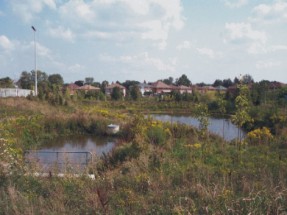
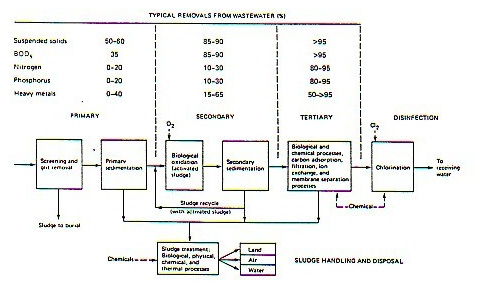


![]() for a bibliography on wetlands
for a bibliography on wetlands



![[Img-CDS+Constructed Wetland]](PIC/cds-wetland.jpg)